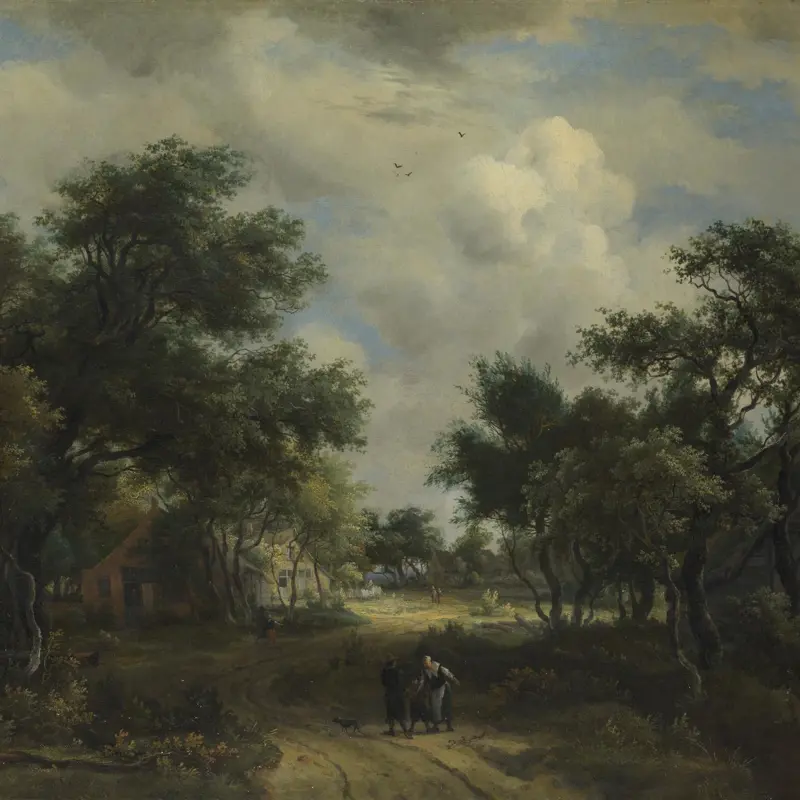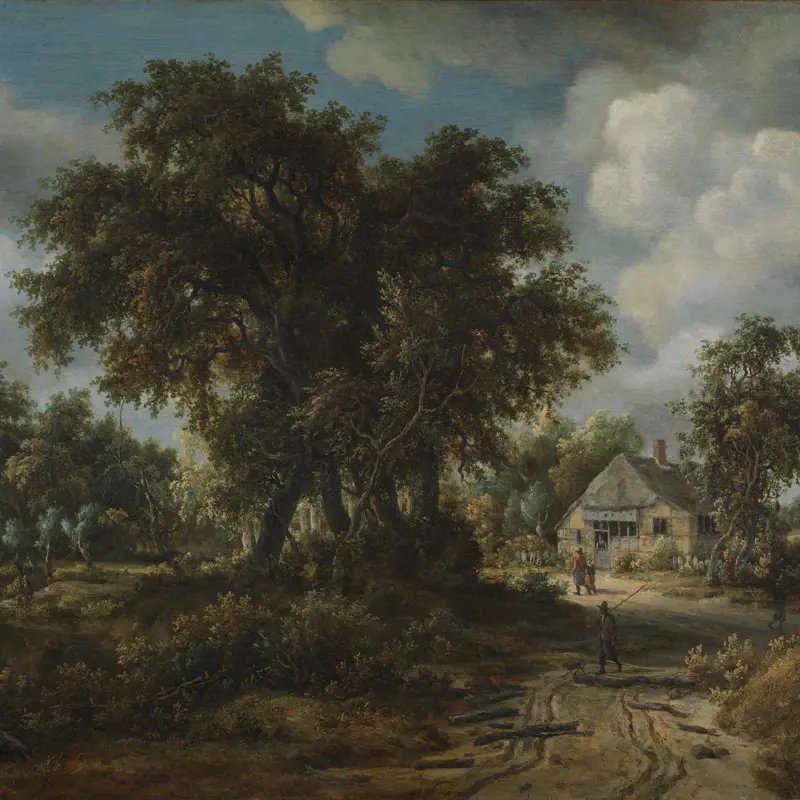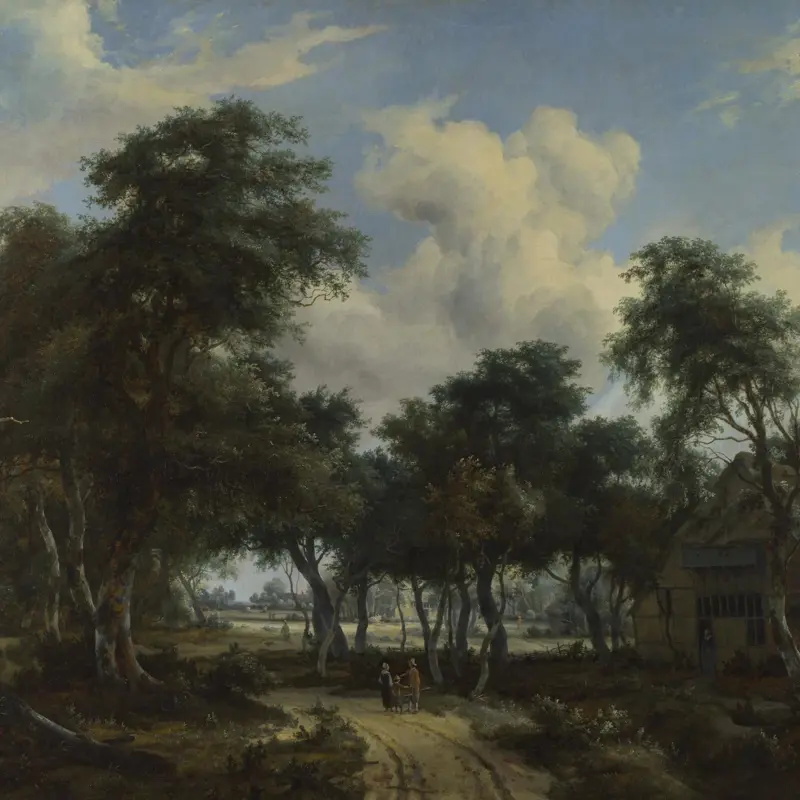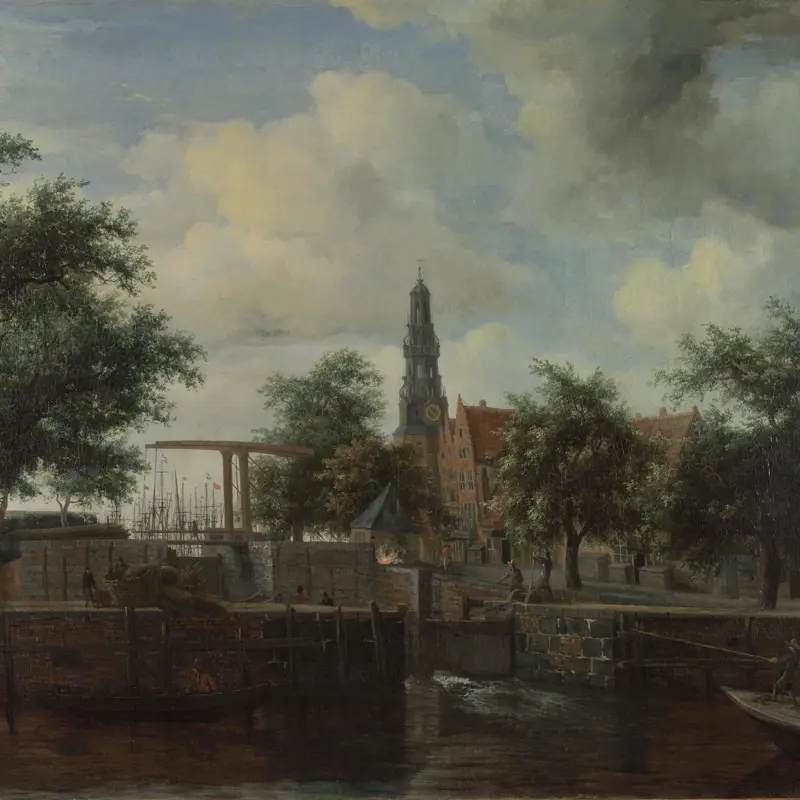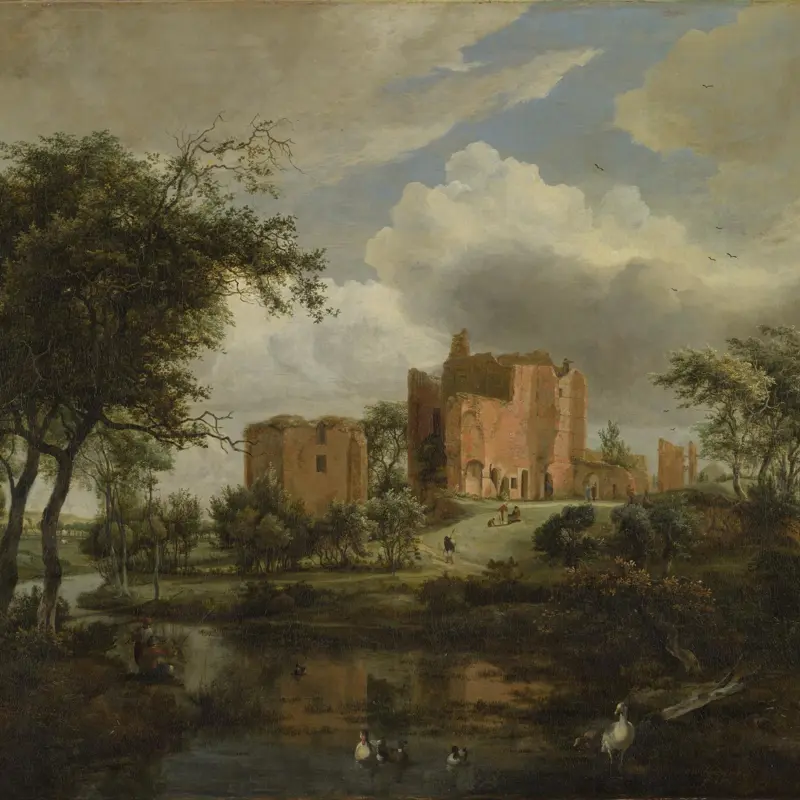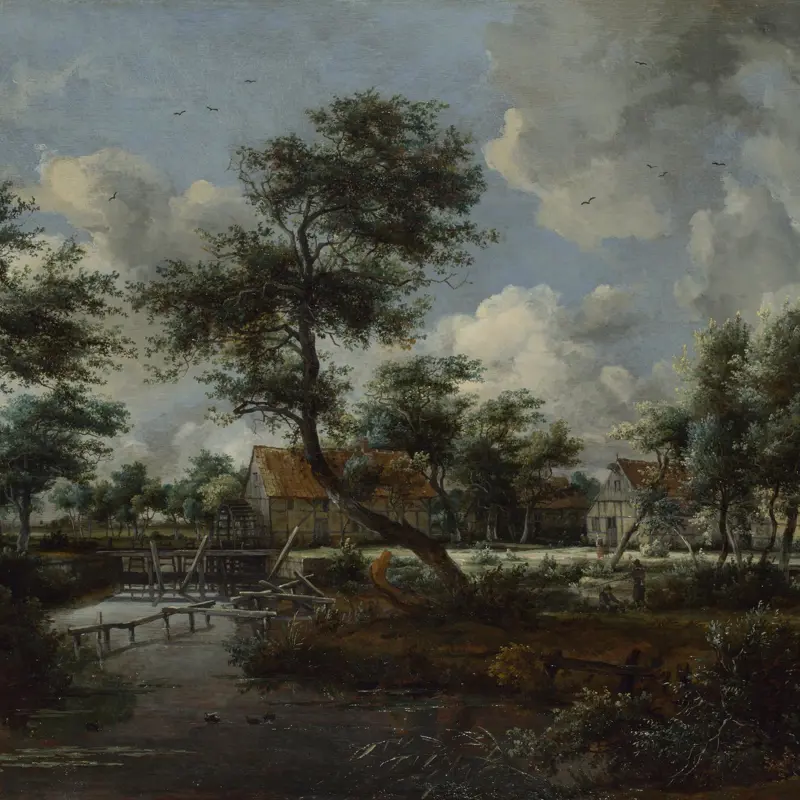Meindert Hobbema, 'The Avenue at Middelharnis', 1689
About the work
Overview
Hobbema has created a remarkable effect in this unusual painting, using the trees of the avenue to funnel our view directly into the heart of the picture and as strong verticals to take the eye upwards. Our gaze is also drawn sideways into the landscape, through both the track which turns off to the right and the strong lateral lines of the paths and fields on the left. It’s as though there is a three-dimensional grid – an invisible geometry – underlying the whole painting.
The composition proved to be a powerful influence on later artists. It was admired by Van Gogh, who emulated its effects in several paintings after he first saw it in the National Gallery in 1884, and it probably also inspired Camille Pissarro’s The Avenue, Sydenham. David Hockney even made his own version in 2017, Tall Dutch Trees After Hobbema (Useful Knowledge).
Key facts
Details
- Full title
- The Avenue at Middelharnis
- Artist
- Meindert Hobbema
- Artist dates
- 1638 - 1709
- Date made
- 1689
- Medium and support
- oil on canvas
- Dimensions
- 103.5 × 141 cm
- Inscription summary
- Signed; Dated
- Acquisition credit
- Bought, 1871
- Inventory number
- NG830
- Location
- Room 19
- Collection
- Main Collection
- Previous owners
- Frame
- 17th-century Dutch Frame
Provenance
Additional information
Text extracted from the ‘Provenance’ section of the catalogue entry in Neil MacLaren, revised and expanded by Christopher Brown, ‘National Gallery Catalogues: The Dutch School: 1600–1900’, London 1991; for further information, see the full catalogue entry.
Exhibition history
-
2019Van Gogh and BritainTate Britain27 March 2019 - 11 August 2019
-
2022Hockney's Eye: The Art and Technology of DepictionThe Fitzwilliam Museum15 March 2022 - 29 August 2022
Bibliography
-
1829
J. Smith, A Catalogue Raisonné of the Works of the Most Eminent Dutch, Flemish, and French Painters: In Which is Included a Short Biographical Notice of the Artists, with a Copious Description of Their Principal Pictures […], 9 vols, London 1829-1842
-
1834C.-J. Nieuwenhuys, A Review of the Lives and Works of Some of the Most Eminent Painters, London 1834
-
1844A.M. Jameson, Companion to the Most Celebrated Private Galleries of Art in London: Containing Accurate Catalogues, Arranged Alphabetically, for Immediate Reference, Each Preceded by an Historical & Critical Introduction […], London 1844
-
1893C. Hofstede de Groot, 'Hobbema's Laantje van Middelharnis', De Nederlandsche Spectator, LXI/8, 1893, pp. 1-4, 61-2
-
1895C. Gerardus, 'Hobbema’s meesterstuk: Het laantje van Middelharnis', De Amsterdammer, 947, 1895, pp. 5-6
-
1907C. Hofstede de Groot, Catalogue Raisonné of the Works of the Most Eminent Dutch Painters of the Seventeenth Century, 10 vols, London 1907
-
1907C. Hofstede de Groot, Catalogue Raisonné of the Works of the Most Eminent Dutch Painters of the Seventeenth Century, 10 vols, London 1907
-
1917K. Blokhuis, 'Hobbema's laantje van Middelharnis', Oude Kunst, III, 1917, pp. 279-84
-
1936H.J.C. Grierson (ed.), The Letters of Sir Walter Scott, 1828-31, London 1936
-
1938G. Broulhiet, Meindert Hobbema (1638-1709), Paris 1938
-
1959W. Stechow, 'The Early Years of Hobbema', Art Quarterly, XXII/1, 1959, pp. 3-18
-
1960Maclaren, Neil, National Gallery Catalogues: The Dutch School, 2 vols, London 1960
-
1966W. Stechow, Dutch Landscape Painting of the Seventeenth Century, London 1966
-
1981National Gallery, 'Pictures Cleaned and Restored in the Conservation Department of the National Gallery, January 1981 - December 1981', National Gallery Technical Bulletin, VI, 1982
-
1983C. Brown, 'Rubens' Watering Place: An Examination of His Landscape Technique', Ringling Museum of Art Journal, 1983, pp. 130-49
-
1991Maclaren, Neil, revised by Christopher Brown, National Gallery Catalogues: The Dutch School, 1600-1900, 2nd edn (revised and expanded), 2 vols, London 1991
-
1991F. Herrmann, 'Peel and Solly: Two Nineteenth-Century Art Collectors and Their Sources of Supply', Journal of the History of Collections, III/1, 1991, pp. 89-96
-
1994M. Warnke, Political Landscape: The Art History of Nature, London 1994
-
1994P. Sutton, The Golden Age of Dutch Landscape Painting (exh. cat. Museo Nacional Thyssen-Bornemisza, 11 November 1994 - 2 February 1995), Madrid 1994
-
1997J.B. Hochstrasser, 'Inroads to Seventeenth-Century Dutch Landscape Painting', Nederlands Kunsthistorisch Jaarboek, XLVIII, 1997, pp. 193-221
-
1998C. Brown, 'Revising the Canon: The Collector's Point of View', Simiolus, XXVI/3, 1998, pp. 201-12
-
1999G. Perry and C. Cunningham (eds), Academies, Museums and Canons of Art, London 1999
-
2001
C. Baker and T. Henry, The National Gallery: Complete Illustrated Catalogue, London 2001
-
2002L. Beheydt, Eén en toch apart: Kunst en cultuur van de Nederlanden, Zwolle 2002
-
2003C. Higgitt, M. Spring and D. Saunders, 'Pigment-Medium Interactions in Oil Paint Films containing Red Lead or Lead-Tin Yellow', National Gallery Technical Bulletin, XXIV, 2003, pp. 75-95
-
2005E. Bergvelt, 'De Britse Parlementaire Enquête uit 1853: De "modernisering" van de National Gallery in London', in E. Bergvelt and D.J. Meijerss (eds), Kabinetten, galerijen en musea: Het verzamelen en presenteren van naturalia en kunst van 1500 tot heden, Zwolle 2005, pp. 319-42
-
2005H.W. van Os, 'The painter he findes at his easill at worke', in M. van den Doel (ed.), The Learned Eye: Regarding Art, Theory, and the Artist's Reputation: Essays for Ernst van de Wetering, Amsterdam 2005, pp. 206-13
-
2007M.E. Wieseman and E. Greer, Dutch Painting: The National Gallery, London 2007
-
2008P. Taylor, 'Flatness in Dutch Art: Theory and Practice', Oud Holland, CXXI/2-3, 2008, pp. 153-84
Frame
This is a seventeenth-century Dutch frame, with an ebonised fruitwood veneer. The reverse ogee moulding has a reeded moulding towards the sight edge.
This frame was sourced in 2019, and fitted to Hobbema’s The Avenue at Middelharnis. For many years, The Avenue at Middelharnis was displayed in a French seventeenth-century decorative gilt frame.
About this record
If you know more about this work or have spotted an error, please contact us. Please note that exhibition histories are listed from 2009 onwards. Bibliographies may not be complete; more comprehensive information is available in the National Gallery Library.

